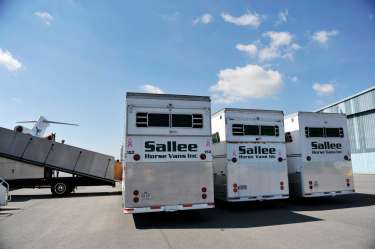
With the tragic news of a horse van catching on fire and all 10 horses dying, I cannot even imagine the pain Trainer Christophe Clement and the owners are enduring. It’s horrible and rare. Everything would have had to happen just right to get the horses off the van. Certainly they could have gotten them off if the doors were not damaged, but not with a raging fire.
There is no better time than now to explain shipping a van load of horses or even one horse. If there is one thing a trainer hates to do, it is to ship. Every time a horse is put on a van, there is a chance for him to get hurt, but it’s the only way you can move a horse for any distance. Most horses get used to shipping and usually things go well; however, you are putting a 1000 lb horse in a rather small stall.
Let me explain a typical horse van. It can hold 15 horses at a time in single stalls. Vans can be reconfigured allowing more space. Most trainers like to give them a stall and a half; however, then the van only holds 10 horses. There were 10 horses in the van that caught fire. If desired, 3 box stalls can be made up which will take up the whole van. A box stall is the safest way to ship a long distance as it allows the horse to walk around, drink, eat hay and lay down. It’s really expensive to ship that way but by far the best and safest way to ship.
Let me explain what most trainers do on shipping day. First of all every horse has to have a health certificate and current Coggins. The veterinarian will come and tube them all with mineral oil (for a long distance ship). That involves putting a rubber tube through the horse’s nose into the stomach. Mineral oil helps prevent horses from getting impacted and unable to relieve themselves. In addition, it helps prevent colic which can be deadly. Then, the trainer, in conjunction with the veterinarian, decides which horses should be sedated which is done to keep the horse calm. Generally once the van is rolling the sedative wears off and the horses are calm. Each horse will be given a rack of hay to eat while on the van. Generally attendants ride with the horses and offer them water every 4-6 hours depending on the weather. There really isn’t much more that can be done for them.
I always want to ship at night for a myriad of reasons. It’s cooler and less traffic. Also, the horses arrive at their destination early the next morning. If something goes awry there are veterinarians open to help. Once the van arrives, the horses are taken off the van. They get a bath, are walked for awhile and then put in a stall. They are allowed to relax. The horses are monitored for development of fever or other signs of illness, such as impaction or colic.
Back in the early days they used trains to ship very long distances. I personally liked that way, but now we fly them. It is very safe but expensive. It’s a matter of money and preferences. As one can see, there are a lot of steps to shipping horses. The most important thing is to deal with a vanning company that is reliable and carries all the insurances and the equipment to do a safe job. Going cheap is not the way to go. Major van companies do it every day without problems. Sallee has all you would want in a shipping company. I’ve used them many times over the years. Our deepest condolences to Christophe, the owners, the caretakers and to Sallee.
I hope that helps you understand little better about shipping long distance.
Photo: Sallee Horse Transportation


